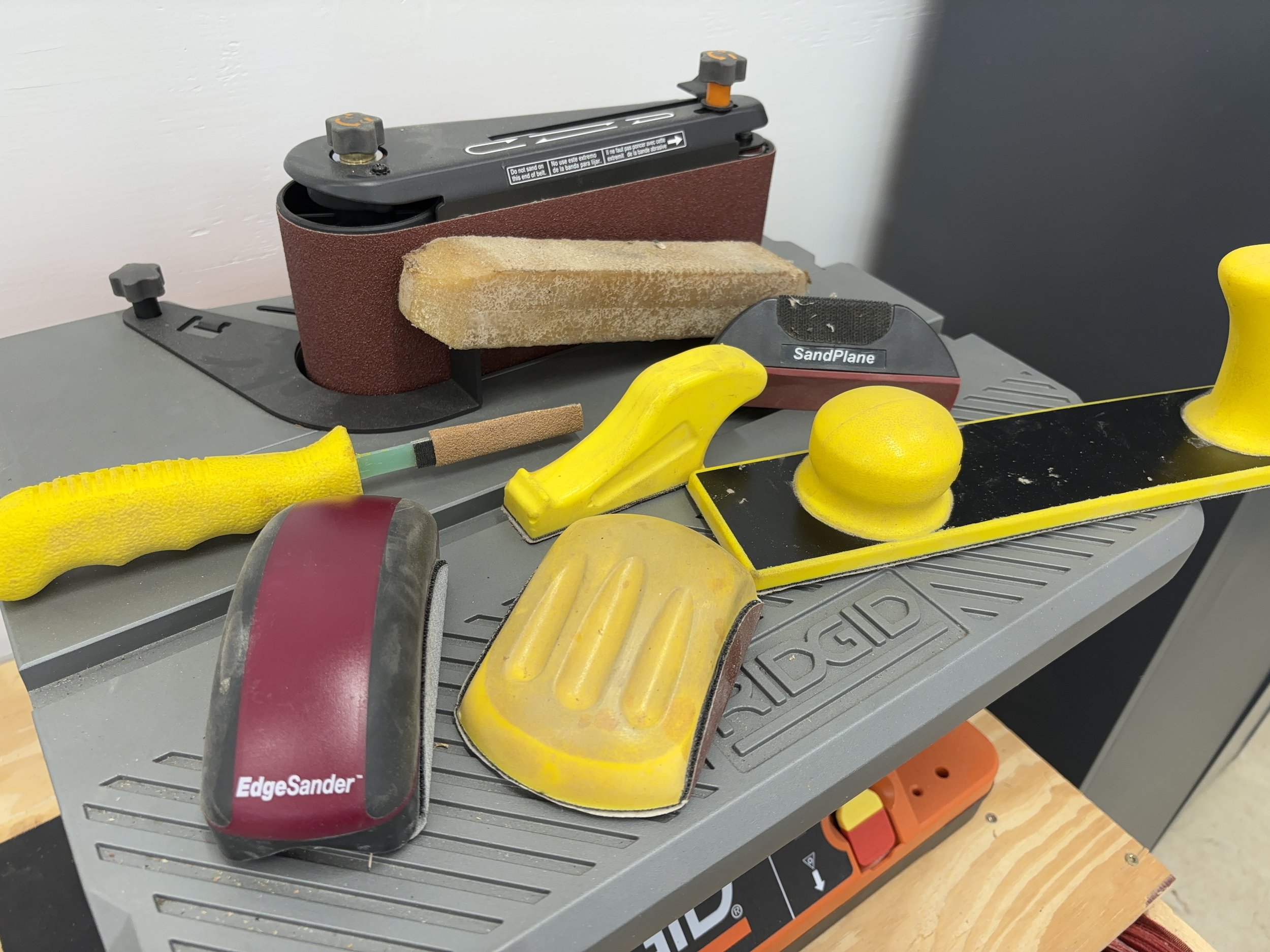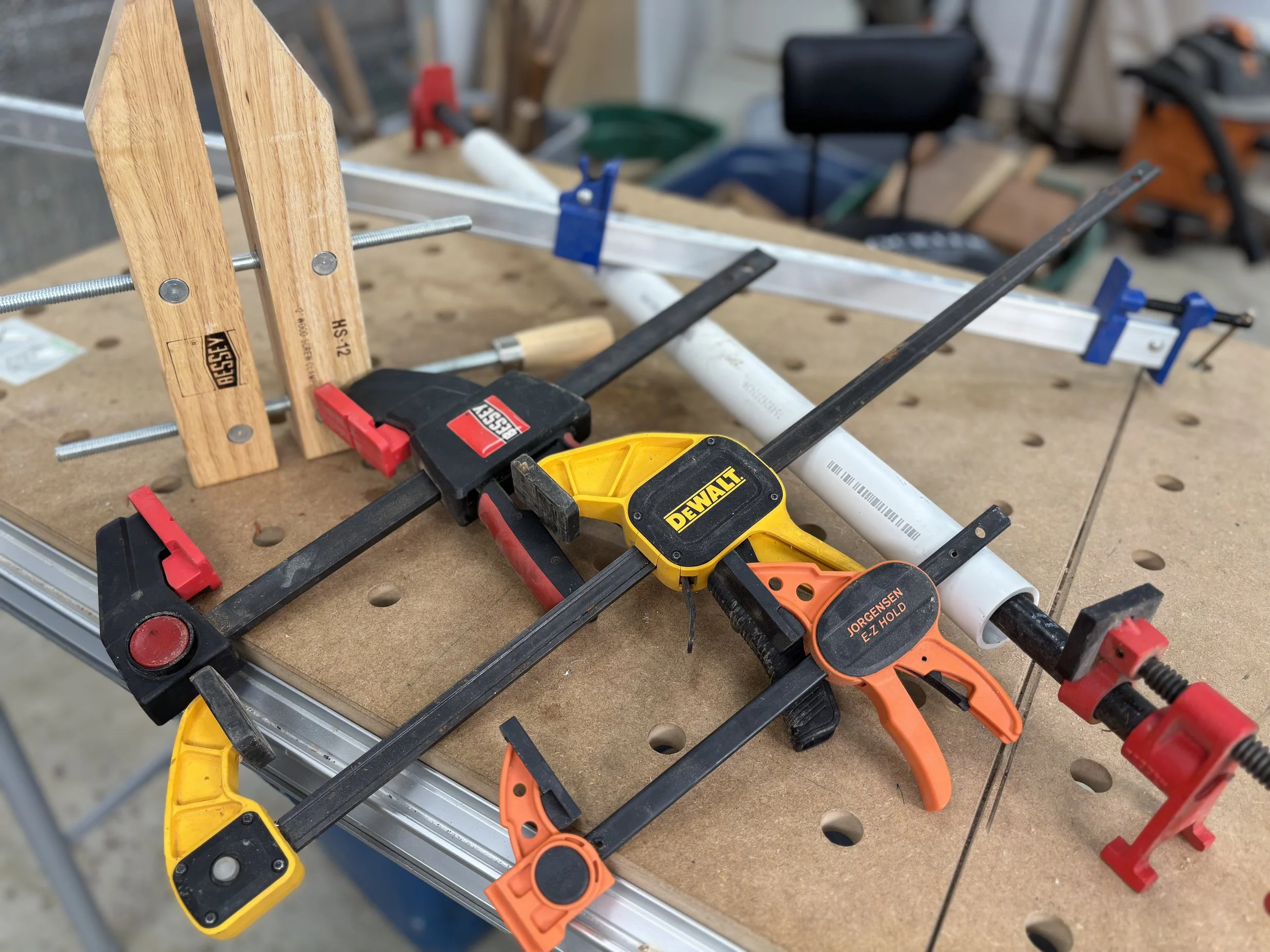The Essentials
Woodworking doesn’t require as many tools as you may think! In fact, it’s one of those hobbies that you start with what you have. Once you improve your skills you will find that you are ready to take on a new tool to add to your collection. Below is a list of some recommendations for tools that I think are great options to start your woodworking journey.
Check back regularly as this list will be updated frequently!
Drills and Drivers:
There are a lot of great options out there. You can start out with just a drill, but most people don’t understand how incredible an impact driver is until they actually use it in a project. That’s why i recommend picking us a drill and driver set. These can usually be picked up for cheap, and will be a tool that you will use on almost every project.
Ryobi One+ 18V Cordless Drill and Driver Set (TOP PICK FOR BEGINNERS)
Miter Saws:
Many people don’t think you need a miter saw. I’m not one them! Miter saws are a wonderful tool that easily and safely allow you to make cross cuts and miter cuts. Things to consider when buying a miter saw are the cut capacity (the width of boards the saw can cut), the angles that the saw can accommodate, and whether or not the saw has a trenching feature. I prefer sliding compound miter saws as these give you the greatest capacity and flexibility to grow with you.
DeWalt 12” Sliding Compound Dual Bevel Miter Saw (TOP PICK FOR BEGINNERS)
Orbital Sanders:
Believe it or not, orbital sanders are the tool you are going to spend the most time with in your shop, and because of this you want one that is comfortable, smooth and ergonomic. Variable speed options are a great add on that you want to look for in an orbital sander.
Ryobi 5” Orbital Sander (TOP PICK FOR BEGINNERS)
DeWalt 5” Variable Speed Orbital Sander (TOP PICK FOR BEGINNERS)
Tools on my wishlist:
Table Saws:
The table saw is the backbone of any workshop, and because of this it is one of the most expensive tools you’ll own. Take some time to figure out what you want out of your table saw. Things I look for are rip capacity, and portability. Jobsite table saws are an excellent choice for starting out, because even if you upgrade your table saw down the road, you will still need that jobsite saw for future home improvement projects. When considering the SawStop technology it is always a good idea to ask yourself, “How much would I pay to have that finger back?” The answer to this question usually makes it easier to stomach the price of a SawStop.
Routers
There are three ways that I use routers in my shop, and because of this I’ve always had a minimum of 3 routers. The first and most used router is the palm router. These are easy to use and can make quick work of adding that subtle round-over to your projects. The second router is the plunge router. These are great for creating dados, juice grooves and so much more. Lastly, I always like to have a powerful router in my router table. This router makes it easy to make micro adjustments to your depth. Having a router table is a great way for a beginner to become more comfortable with this powerful tool.
DeWalt 1.25HP Corded Palm Router (TOP PICK FOR BEGINNERS)
Router Tables & Lifts:
Tools on my wishlist:
Circular Saws:
Unlike with table saws (where you bring your wood to your saw) circular saws allow you to bring your saw to the wood. These amazing tools are one of the first tools that you should ever purchase. Circular saws are excellent for breaking down plywood or doing rough cross cuts. I recommend having a circular saw with at least a 7.25” blade so that you can cut through thicker stock. A track is also a great accessory to have with a circular saw to assist you in making the most accurate cuts on your plywood.
Jointers & Planers
Do you need a jointer and a planer? At first probably not, but the more you projects you do the more you will realize you’re tired of paying the price of pre surfaced lumber. Having a jointer and a planer opens up the new world of visiting sawmills and buying rough cut lumber. I always recommend starting off with a planer and then moving into a jointer when you are ready. There is something really satisfying about turning a piece of rough wood into a beautiful piece of workable lumber!
Planers:
Craftsman 12” Planer (TOP PICK FOR BEGINNERS)
Jointers:
Craftsman 6” Benchtop Jointer (TOP PICK FOR BEGINNERS)
Accessories:
Tools on my wishlist:
Drill Presses:
Drill presses are a total luxury for a workshop. You will be able to use your handheld drill for most of the projects you do, but one day you’ll have that one project where you’ll finally say, “It’s time for a drill press!”. For repeatability and accuracy you can’t beat the precision that a drill press offers.
Bandsaws:
Surprisingly, the bandsaw was one of the first major tools I purchased in my woodworking career. I think that is because it is such a versatile tool. The flexibility and freedom you have with your cuts on a bandsaw allows you to really step up your creativity. Things that I look for in a bandsaw are it’s horizontal and vertical capacity and it’s ability to re-saw. If you are like me a bandsaw will be one of your favorite tools in your shop!
Ryobi 9” Bandsaw (TOP PICK FOR BEGINNERS)
Measuring & Marking:
Measure twice cut once… Sure we all try and do it, but it’s nice to have enough confidence in a tool to measure once and cut once. That’s why I think it is so important to invest in a high quality measuring device that will last you for years. All of these tools have the accuracy and precision to get you though all of your projects.
Dust Collection:
Dust collection was something that I just didn’t think was that important when I first started woodworking. But once I started hacking away after a day in the shop, I began to realize how important it is to have clean air in your shop. Not only does it keep your shop clean and protect your lungs, but dust collection on tools like your sander can actually improve the quality of your work!
Sanding:
Unfortunately we aren’t always sanding a flat surface, that’s why it’s nice to have a lineup of sanding accessories to tackle every situation. These are some of my most commonly used tools to get that silky smooth surface everytime.
Ridgid Oscillating Belt and Spindle Sander (TOP PICK FOR BEGINNERS)
Clamps:
You can never have to many clamps right? Well, I would tend to agree with that statement, but let’s make sure you have the right kind of clamps. From pipe clams, to screw clamps, to quick clamps these are the clamps that I think every workshop can benefit from.
Irwin Quick Clamps (TOP PICK FOR BEGINNERS)
Safety:
The most important thing in your shop may be from this list below. From eye protection, to lung protection, to even finger protection, you always want to have as much safety equipment in your shop as possible. If you want to continue this hobby for years, these are some of the accessories I recommend the most.
Blades & Bits:
Are you getting burn marks on your wood? Does that miter saw seem to give a little bit more resistance when you pull the blade through your wood? Well it may be time to replace those blades and bits. These are some of my most commonly used blades and bits that leave you with clean, burn free, smooth cut surfaces.
Saw Blades
Router Bits
Miscellaneous Power Tools:
Building a tool inventory can be a really confusing process. The good news is you will inherently figure out what tool you need next as you increase your skills and create new projects that need new tools. Here are just a few that I have accumulated over the years that I think are a valuable addition to any shop!
Consumables:
Not all of the materials we use in the shop will last forever. From sandpaper to wood glue, you will constantly be replacing your consumables the more woodworking you do. I’ve tried a lot of different types of consumables over the years, and these are all the ones I think are high quality and worth the money.

















